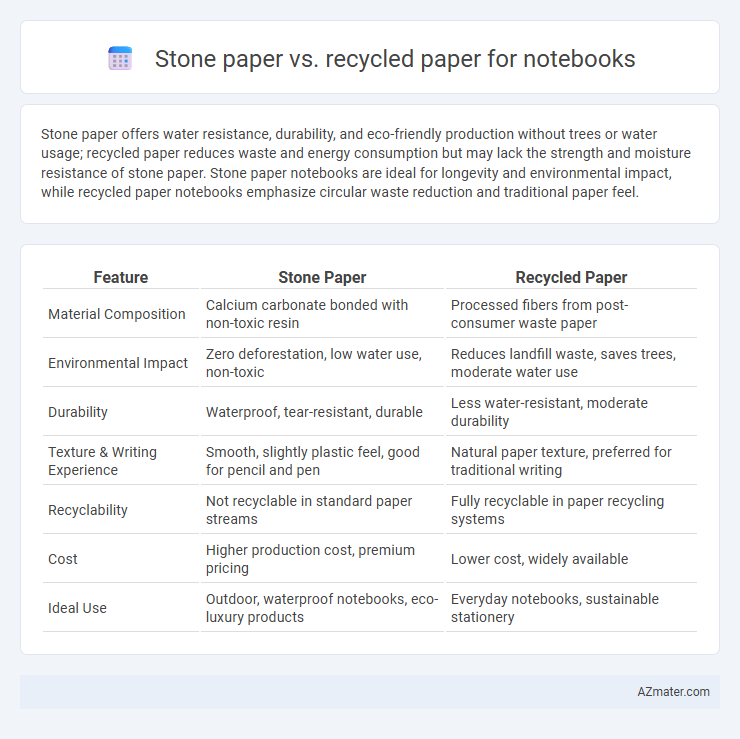Stone paper offers water resistance, durability, and eco-friendly production without trees or water usage; recycled paper reduces waste and energy consumption but may lack the strength and moisture resistance of stone paper. Stone paper notebooks are ideal for longevity and environmental impact, while recycled paper notebooks emphasize circular waste reduction and traditional paper feel.
Table of Comparison
| Feature | Stone Paper | Recycled Paper |
|---|---|---|
| Material Composition | Calcium carbonate bonded with non-toxic resin | Processed fibers from post-consumer waste paper |
| Environmental Impact | Zero deforestation, low water use, non-toxic | Reduces landfill waste, saves trees, moderate water use |
| Durability | Waterproof, tear-resistant, durable | Less water-resistant, moderate durability |
| Texture & Writing Experience | Smooth, slightly plastic feel, good for pencil and pen | Natural paper texture, preferred for traditional writing |
| Recyclability | Not recyclable in standard paper streams | Fully recyclable in paper recycling systems |
| Cost | Higher production cost, premium pricing | Lower cost, widely available |
| Ideal Use | Outdoor, waterproof notebooks, eco-luxury products | Everyday notebooks, sustainable stationery |
Introduction to Stone Paper and Recycled Paper
Stone paper, made from calcium carbonate bonded with non-toxic resin, offers a waterproof and tear-resistant alternative to traditional paper, ideal for durable notebooks. Recycled paper is produced by reprocessing used paper fibers, significantly reducing environmental impact through lower energy consumption and reduced deforestation. Both materials provide eco-friendly options for notebooks, with stone paper emphasizing durability and recycled paper focusing on sustainability.
Manufacturing Process Comparison
Stone paper manufacturing involves crushing limestone into fine powder, mixing it with non-toxic resin, and then heating and pressing it into sheets, resulting in a water-resistant and tear-resistant material without the use of water or trees. Recycled paper production starts with collecting used paper, which is then cleaned, pulped, and processed to remove inks and contaminants before being reformed into new sheets, consuming significant water and energy resources. The stone paper process reduces deforestation and water consumption compared to recycled paper manufacturing but involves resin that affects recyclability and biodegradability.
Environmental Impact Assessment
Stone paper production eliminates the need for water, bleach, and tree cutting, reducing deforestation and water pollution compared to recycled paper, which still requires energy-intensive pulping and chemical treatments. Although recycled paper reduces landfill waste and minimizes raw material demand, its production involves significant water consumption and potential chemical runoff. Stone paper's durability and biodegradability under specific conditions provide a lower carbon footprint and reduced ecological disruption in environmental impact assessments.
Durability and Water Resistance
Stone paper notebooks offer superior durability compared to recycled paper, as they are tear-resistant and do not easily crease or rip under stress. Their water resistance is notable, with stone paper repelling water effectively and preventing ink from bleeding, unlike recycled paper which absorbs moisture and deteriorates quickly when wet. The durability and water resistance of stone paper make it an ideal choice for notebooks used in outdoor or high-moisture environments.
Writing Experience and Texture
Stone paper offers a smooth, waterproof surface that resists ink bleed and provides a uniquely glossy texture, enhancing the writing experience with effortless pen glide. Recycled paper provides a more traditional, slightly rough texture that absorbs ink differently, often resulting in a more tactile and organic feel, though it may cause occasional feathering or bleed-through. Writers seeking durability and a sleek finish prefer stone paper, while those valuing eco-friendliness and classic paper feel lean towards recycled paper notebooks.
Cost and Market Availability
Stone paper notebooks generally have a higher production cost due to the use of calcium carbonate and resin, making them more expensive than recycled paper notebooks. Recycled paper notebooks benefit from widespread availability and established supply chains, leading to lower costs and easier access in the market. While stone paper offers water resistance and durability, recycled paper dominates the market with affordability and eco-friendly appeal.
Biodegradability and End-of-Life Disposal
Stone paper, made from calcium carbonate bonded with resin, offers water resistance and tear durability but lacks biodegradability due to its plastic content, complicating end-of-life disposal and requiring specialized recycling methods. Recycled paper notebooks, derived from post-consumer fibers, are fully biodegradable and compostable, enabling eco-friendly disposal and integration into circular waste management systems. Choosing recycled paper supports sustainable lifecycle practices, whereas stone paper demands infrastructure for effective material recovery to minimize environmental impact.
Printing and Ink Compatibility
Stone paper offers superior printing quality with its smooth, non-porous surface that prevents ink bleeding and smudging, making it ideal for high-detail prints and vibrant colors. Recycled paper, while eco-friendly, often exhibits a rougher texture that can absorb ink unevenly, resulting in less sharp images and potential fading over time. Ink compatibility on stone paper typically requires pigment-based inks for optimal adhesion, whereas recycled paper accommodates a broader range of ink types but with variable consistency in print clarity.
Popular Brands and Product Options
Stone paper notebooks from popular brands like Karst and YUPO offer waterproof, tear-resistant pages that appeal to eco-conscious consumers seeking durability and sustainability. Recycled paper options from brands such as Hammermill and Ecojot prioritize post-consumer fiber usage, providing familiar texture and affordability while reducing deforestation impact. Both product lines feature various sizes and binding types, catering to diverse preferences in notebook design and environmental responsibility.
Choosing the Best Notebook Material
Stone paper offers superior durability and water resistance compared to recycled paper, making it ideal for notebooks used in outdoor or rugged environments. Recycled paper provides an eco-friendly choice by reducing waste and conserving trees, appealing to environmentally conscious users. Selecting the best notebook material depends on prioritizing water resistance and longevity with stone paper or sustainability with recycled paper.

Infographic: Stone paper vs Recycled paper for Notebook
 azmater.com
azmater.com